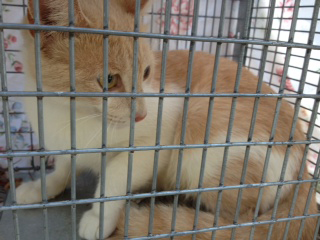Volunteers Keep Cat Population in Check

This young female was recently captured and treated according to the trap, neuter, release method prescribed by the Humane Society for controlling cat populations on college campuses and similar environments. (Image courtesy of Marilyn Smith)
“Adopt a Tech kitten or cat … Reduced adoption fees for employees, students, and affiliates.” This ad in The Whistle classifieds has left some members of the campus community puzzled. Georgia Tech has cats?
The short answer to that question is yes. “Every place has cats,” said Marilyn Smith, professor in the School of Aerospace Engineering. “No matter where.”
It’s a fact, but it doesn’t have to be a problem — and that’s where Smith and other volunteers come in. This small, unofficial group, known as Campus Cats, has worked since 1997 to keep Tech’s cat population as small and healthy as possible.
Back then, cat sightings were alarmingly frequent due to a number of construction projects that disturbed their secluded habitats. A few concerned Auxiliary Services staffers put out a call for volunteers, and the group’s first inventory revealed close to 200 feral cats living on Tech’s 450 acres.
Volunteers began capturing, spaying or neutering, and vaccinating the feral cats before releasing them back onto campus. Any kittens or newly abandoned (i.e., tame) cats that were discovered were rescued, treated, and put up for adoption. Central to this effort were feeding stations — set up off the beaten path to avoid compromising the campus aesthetic — to ensure the cats were nourished and also to give volunteers a means to monitor the population.
One fecund feline in particular, Mama Calico, has eluded capture for almost 10 years, but hundreds more have been caught and fixed or adopted out.
Through these methods (sanctioned by the Humane Society of America), the campus cat population has been greatly reduced. In recent years, it has been holding steady at about 40 to 50 cats, estimated Josie Giles, marketing and communications manager for Robotics and Big Data. Giles coordinates Campus Cats activities and runs Krazy About Kats, a nonprofit organization (not affiliated with Tech) that helps many Tech rescues find a home.
In time, the campus cat population may get even smaller, but nature guarantees it will never be zero. “If you actually trapped all the cats and moved them somewhere else, you will get more cats here,” Giles said. “Nature does hate a void. ”
Having a healthy population of cats staking out Tech territory helps discourage abandoned or feral cats from surrounding neighborhoods from migrating onto campus, Giles pointed out. Unfortunately, she added, some cats are deliberately “dumped” on campus.
“Research by the Humane Society shows that campuses are the No. 3 place people dump animals, after vets and shelters,” Giles said. “And honestly, statistically, quoting the Humane Society, many of the animals that are dumped come from students themselves.”
Smith said there’s a misconception that campuses are a safe place to abandon a cat. “Please let everybody know that dumping a cat on campus is not appropriate,” she said. “If they’ve [the cat] been inside, they don’t know how to adapt. There are predators. They might get killed by a fox or run over.”
Another misconception, Smith said, is that the cats might pose a threat to humans or birds. “These cats are not hungry, they’re healthy, so they’re only going to go after the easy ground prey — voles, moles, and rats — things we don’t want on campus,” she said. “And they’re not going to menace anybody. They don’t come to me, and I feed them! They’re certainly not going to go after students.”
For more information or to help, contact email Giles or Smith.